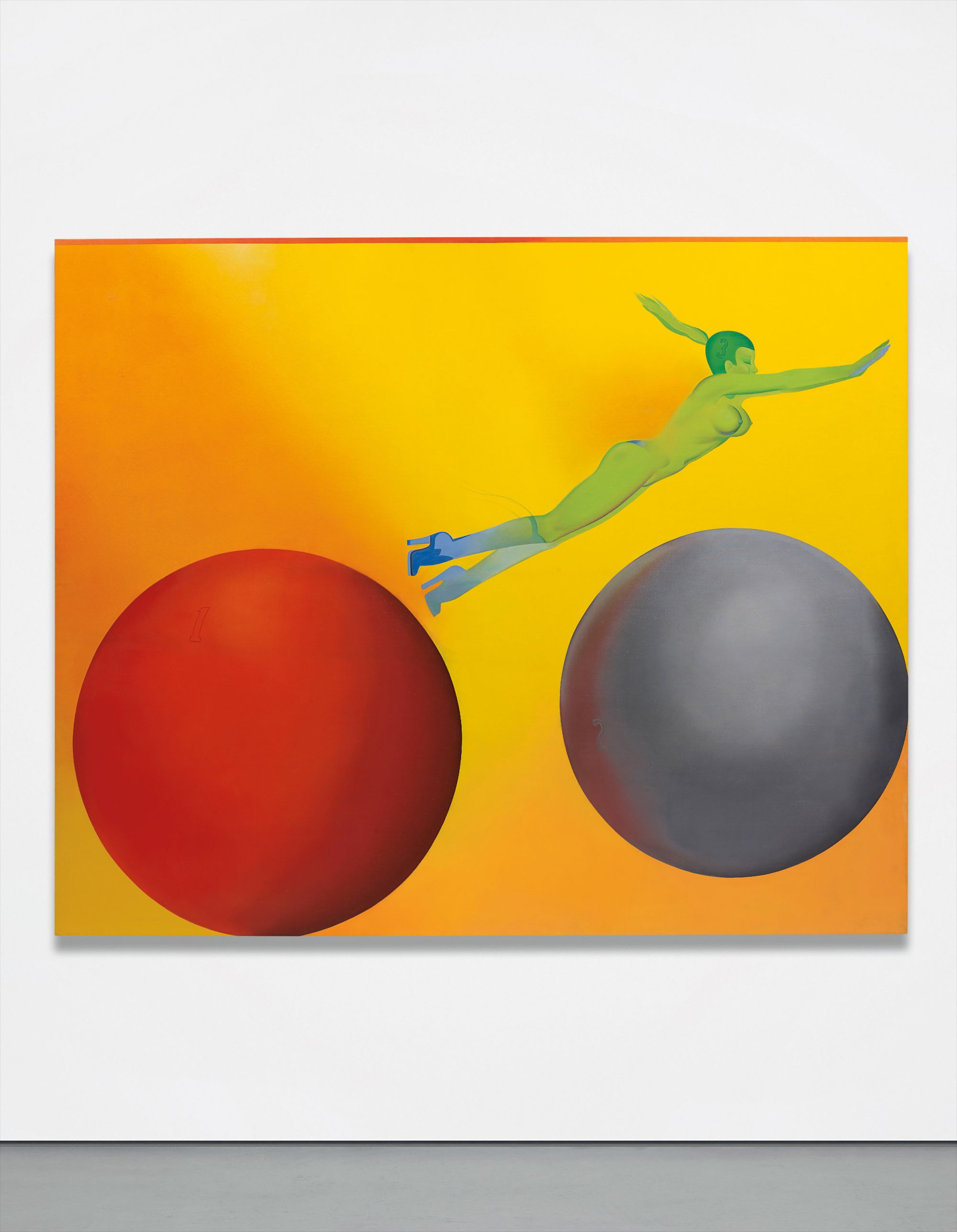

132
Allen Jones
Float
acrylic on canvas
274 x 335 cm (107 7/8 x 131 7/8 in.)
Signed, titled and dated 'Allen Jones "Float" 1972 on the overlap.
Full-Cataloguing
Allen Jones had a clear mission in 1972: ‘I wished to paint a figure flying through the air,’ he explained ahead of his first major retrospective the following year. The work Jones was referring to is the present lot, the magnificent work on canvas, Float. Jones certainly succeeded in his mission as the gravity defying woman leaps across the surface of the canvas in sublimely Jonesian fashion. Mastered here, the painting has achieved a sensory experience that extends beyond the picture plane. Jones himself continues, ‘The way the figure was used and why it ends where it does is for a very pictorial reason: in grammatical terms it acts as an acute accent, which seems to hang in an allusion of space created by the two spheres…’ (Allen Jones in conversation with Marco Livingstone 13 July 1978, in Allen Jones: A Retrospective of Paintings 1957-1978, exh. cat., Liverpool: Walker Art Gallery, 1979, pl. 40)
Thus, the picture unfolds when the individual narrative elements are not ends in and of themselves. Harking back to the fin-de-siècle, synaesthetia, a neurological phenomenon embraced by the likes of Rimaud, Wagner and Kandinsky in their respective fields, is the sensation experienced when one looks at Float. The synaesthetic dictated a sensory experience where one sense was expressed through another. For example: a sense of taste through sight, or colour through sound. Jones, influenced by Wassily Kandinsky, especially in the use of colour and form, certainly explores the triggers of multi-sensory experience. When looking at Float, the sight triggers the corporeal. Achieved through the allusion of space, where the flat swathes of colour from the tonal spheres to the background in a golden yellow burning out to rust, escapes physics, forcing a guttural, physical response from the viewer.
Jones succinctly navigates the figurative form and targeted use of colour. Recalling the iconic comic book character Wonder Woman as she soars through the air, the figure is one of strength and beauty. The figure merges with ambiguity in abstraction. Reminiscent of Marc Chagall’s gravity defying figures – ungrounded in their interior space, such as Birthday from 1915 – Jones extends further into abstraction by negating the setting altogether. From form to colour, Jones admired the abstract expressionism of Kandinsky, who has described colour ‘as a means of exerting direct influence on the soul’ (K. Ruhrberg, K. Honnef, Art of the 20th Century, Part 1, London: Taschen, 2000, p. 105). Combined with the sensationalism of synaesthesia – Float is an electrifying journey through space, time and the mind.
Thus, the picture unfolds when the individual narrative elements are not ends in and of themselves. Harking back to the fin-de-siècle, synaesthetia, a neurological phenomenon embraced by the likes of Rimaud, Wagner and Kandinsky in their respective fields, is the sensation experienced when one looks at Float. The synaesthetic dictated a sensory experience where one sense was expressed through another. For example: a sense of taste through sight, or colour through sound. Jones, influenced by Wassily Kandinsky, especially in the use of colour and form, certainly explores the triggers of multi-sensory experience. When looking at Float, the sight triggers the corporeal. Achieved through the allusion of space, where the flat swathes of colour from the tonal spheres to the background in a golden yellow burning out to rust, escapes physics, forcing a guttural, physical response from the viewer.
Jones succinctly navigates the figurative form and targeted use of colour. Recalling the iconic comic book character Wonder Woman as she soars through the air, the figure is one of strength and beauty. The figure merges with ambiguity in abstraction. Reminiscent of Marc Chagall’s gravity defying figures – ungrounded in their interior space, such as Birthday from 1915 – Jones extends further into abstraction by negating the setting altogether. From form to colour, Jones admired the abstract expressionism of Kandinsky, who has described colour ‘as a means of exerting direct influence on the soul’ (K. Ruhrberg, K. Honnef, Art of the 20th Century, Part 1, London: Taschen, 2000, p. 105). Combined with the sensationalism of synaesthesia – Float is an electrifying journey through space, time and the mind.